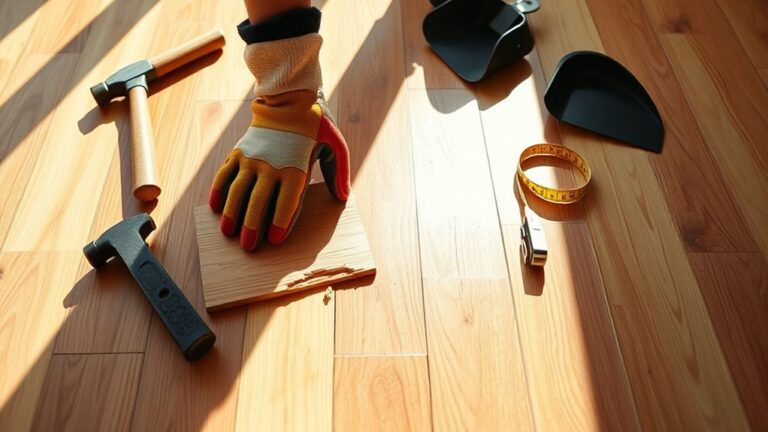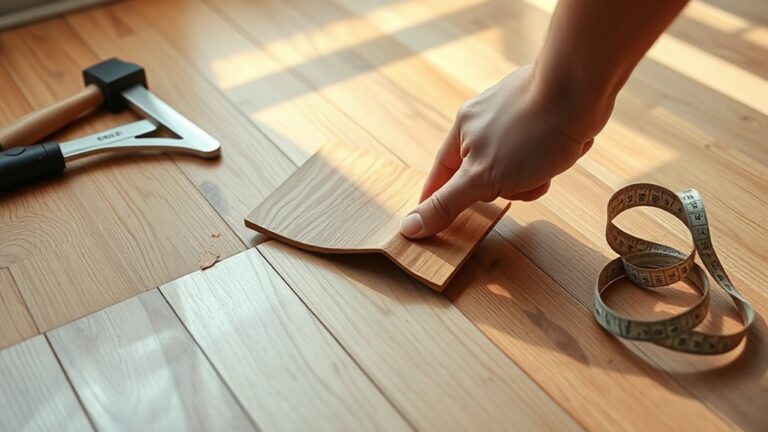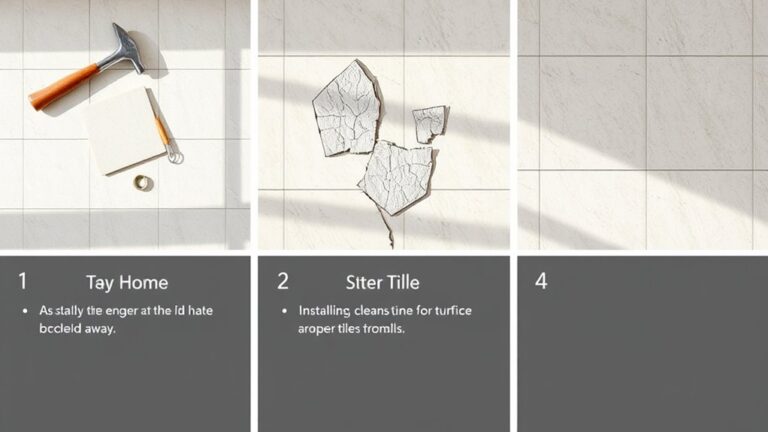To tackle loose carpet installation, start by inspecting areas for damage to tackless strips or insufficient tension. Use a knee kicker or power stretcher to properly stretch the carpet, securing it with staples along the edges. Regular vacuuming and humidity control can prevent future loosening, especially in high-traffic areas. If extensive damage is present or if you face a complex room layout, consider enlisting a professional. They have the tools and expertise to guarantee a seamless installation. With proper attention to maintenance and stretching, you can greatly improve your carpet's longevity and appearance, and there's more to explore on this topic.
Understanding Loose Carpet Causes
Loose carpet can be a frustrating issue in any home, and understanding its causes is crucial for effective solutions. One primary factor contributing to loose carpet is the age and wear of carpet fibers. Over time, these fibers can lose their tension and support, leading to noticeable looseness. Additionally, damage to tackless strips, which serve to secure carpet edges, often results in detachment and can exacerbate the problem.
Foot traffic plays a significant role in this process, especially in high-traffic areas like hallways and living rooms. The constant pressure can accelerate wear and contribute to loosening. Furthermore, fluctuations in humidity can further impact carpet fibers, causing them to expand and contract. This movement can lead to gaps and looseness over time, especially if the carpet has not been installed with adequate care.
Improper installation techniques are another critical factor. If the carpet isn't stretched properly during installation or if the tack strips are insufficient, it can result in loose areas shortly after the carpet is laid. Ensuring that the carpet is well-stretched and securely attached to the tackless strips is essential for maintaining carpet support.
Effective Repair Techniques
To effectively repair loose carpet, start by inspecting the affected sections to pinpoint any damage to the tackless strips that might be causing the problem. Once you've identified the loose areas, fold back the carpet to access the underlying surface, allowing you to stretch and secure it properly with a knee kicker. This will guarantee a snug fit and prevent future loosening, especially in high-traffic zones.
Inspect Loose Sections
Regularly inspecting your carpet for loose sections is essential to maintaining its appearance and longevity. Start by focusing on areas near walls, boundaries, and high-traffic zones, where carpets are prone to loosening. Here's how to effectively assess your carpet:
- Fold Back the Carpet: Carefully lift the loose sections to expose the underlying flooring and check for any tack strips.
- Assess Tack Strips: Look for damaged or missing tack strips. If you find any, replace them to guarantee the carpet can be properly secured once it's re-stretched.
- Use a Knee Kicker: Stretch the carpet tightly across the affected area using a knee kicker. This tool helps embed the carpet securely into the newly installed or repaired tack strips.
After stretching, secure the carpet by placing staples every few inches along the edges. This prevents future loosening and provides a neat finish. By following these steps, you can maintain a tight, well-secured carpet that enhances your space's overall look and durability. Regular inspections will help you catch issues early and extend the life of your flooring.
Stretch and Secure
After inspecting the loose sections and addressing any damaged tack strips, it's time to focus on stretching and securing the carpet effectively. Begin by carefully folding back the carpet to reveal the underlying tack strip. If any tack strips are damaged or missing, replace them before proceeding; this step is essential for proper carpet adhesion.
Next, use a knee kicker to stretch the carpet tightly over the affected area. Make sure that the carpet backing is firmly embedded into the tack strips, which will help prevent future looseness. Once the carpet is stretched, secure it in place with staples every few inches along the edge. This added stability is important for maintaining your carpet's integrity and preventing further loosening.
Preventive Maintenance Strategies
To maintain the integrity of your carpet, regular vacuuming at least once a week is essential, as it prevents dirt buildup that can lead to accelerated wear. Additionally, controlling indoor humidity between 30% and 50% will help avoid fluctuations that cause carpet fibers to stretch and loosen. By implementing these preventive maintenance strategies, you can greatly prolong the lifespan and appearance of your carpet.
Regular Vacuuming Benefits
Maintaining the integrity of your carpet involves more than just occasional cleanings; it's about consistent care, and vacuuming plays an essential role in that process. Regular vacuuming helps eliminate dirt and debris that can penetrate carpet fibers, preventing premature wear and ensuring your carpet looks its best longer.
To maximize the benefits of vacuuming, consider the following strategies:
- Vacuum High-Traffic Areas Twice a Week: This frequency minimizes dirt buildup, prolonging your carpet's lifespan and maintaining its appearance.
- Utilize a HEPA Filter Vacuum: Vacuums equipped with HEPA filters effectively capture allergens and dust mites, improving indoor air quality and creating a healthier living space.
- Preserve Pile Height: Consistent vacuuming helps maintain the pile height of your carpet, reducing the likelihood of developing loose areas that can compromise its integrity.
Moreover, regular vacuuming enhances the effectiveness of professional cleanings by removing surface debris, allowing deeper cleaning of the fibers. By adopting these vacuuming practices, you not only protect your investment but also contribute to a healthier, more inviting home environment.
Humidity Control Techniques
While regular vacuuming is crucial for carpet upkeep, managing indoor humidity levels is equally important for preventing damage over time. Maintaining humidity control within 30% to 50% can greatly reduce carpet expansion and contraction, which helps preserve your carpet integrity. In areas prone to high moisture, like basements and bathrooms, using a dehumidifier can effectively manage humidity levels.
Additionally, regularly using exhaust fans in kitchens and bathrooms will minimize humidity spikes caused by cooking and showers, further protecting your carpets from loosening. It's equally important to guarantee proper ventilation throughout your home to encourage air circulation, stabilizing humidity levels.
To take proactive measures, consider installing a hygrometer to monitor humidity. This tool allows you to make timely adjustments, guaranteeing your environment remains conducive to maintaining your carpets. By implementing these techniques, you can greatly reduce the risk of loose carpet and extend the life of your flooring. Remember, a consistent approach to humidity control not only enhances comfort but also safeguards your investment in quality carpets. Prioritize these strategies, and enjoy a beautiful, well-maintained space.
Common Carpet Issues Explained
Loose carpet isn't just an aesthetic concern; it can lead to a range of functional issues in your home. Understanding the common problems associated with loose carpet will help you maintain a safe and appealing living space. Various factors contribute to this issue, often stemming from improper installation techniques or environmental influences.
Here are three prevalent carpet issues you might encounter:
- Improper Installation: If your carpet isn't secured adequately to tack strips or if insufficient stretching has occurred, you'll likely notice areas where the carpet is starting to detach. This can create tripping hazards and detract from the overall look of your home.
- Heavy Foot Traffic: Areas that experience heavy foot traffic are particularly susceptible to wear and loosening of carpet fibers. Over time, the constant pressure can lead to noticeable loosening, especially if the carpet was not installed with adequate tension.
- Humidity Fluctuations: Changes in humidity can cause carpet fibers to expand and contract, contributing to looseness as the material struggles to adapt to the environment. In homes with inconsistent climate control, this issue can become pronounced.
Carpet bunching, another common issue, often arises in larger rooms due to insufficient tension in the carpet. Thankfully, this can frequently be corrected using stretching techniques. If you find that your carpet continues to loosen, you may need to evaluate the replacement of tackless strips or employ a professional to guarantee a tighter fit.
When to Seek Professional Help
When dealing with carpet installation issues, knowing when to seek professional help can save you time, effort, and money. If you're facing extensive damage that covers a large area of your carpet, it's advisable to call in the pros. They can guarantee proper carpet stretching and repair, preventing further complications down the line.
Complex room layouts with multiple angles and shifts can be tricky to handle. A professional installer has the experience to navigate these challenges, achieving a seamless finish that DIY projects might not deliver. Additionally, if you lack the necessary tools like a power stretcher or knee kicker, attempting the job yourself can lead to costly mistakes.
If you're inexperienced with carpet installation techniques, hiring a professional is wise. Over-stretching or creating improper tension can result in additional damage that could have been avoided. Professionals typically charge between $100 and $140 per room, which can be a worthwhile investment for guaranteeing that your carpet not only looks great but also lasts longer.
Essential Tools for Stretching Carpet
Understanding the tools necessary for effective carpet stretching is vital, especially if you decide to tackle the project yourself. Having the right equipment can make a significant difference in achieving a professional finish. Here are three important tools you'll need:
- Power Stretcher: This tool is essential for stretching larger carpet areas. It features adjustable telescoping tubes that can extend up to 40 feet, allowing you to create the necessary tension for a smooth installation. The adjustable teeth grip the carpet securely, preventing slippage during the stretching process.
- Knee Kicker: Ideal for tight spaces and areas within 3 feet from walls, the knee kicker is a compact tool about 20 inches long. It's designed to guarantee proper carpet embedding in corners or narrow areas where a power stretcher can't reach. Like the power stretcher, it also has adjustable steel teeth for a firm grip.
- Utility Knife: A sharp carpet or utility knife is vital for trimming excess carpet accurately. It guarantees you have clean edges that contribute to a neat finish after installation.
In addition to these primary tools, consider using a hammer tacker and staple gun for fastening carpet edges and securing padding. Together, these tools provide a thorough approach to stretching carpet effectively, helping you achieve a professional-looking installation with ease.
Frequently Asked Questions
How to Secure a Loose Carpet?
To secure a loose carpet, you'll want to start with a thorough carpet inspection checklist to identify problem areas. Consider using carpet adhesive options for stubborn sections. Employ carpet stretching techniques with installation tools like a knee kicker to guarantee a tight fit. For long-term maintenance, explore carpet padding types and follow carpet cleaning methods that suit your fibers. Watch for carpet wear patterns and signs of replacement to maintain your investment.
What Is an Alternative to Carpet Stretcher?
When it comes to alternatives for a carpet stretcher, you've got options that can really make a difference. A knee kicker is a handy tool for smaller areas, allowing you to make adjustments without a full stretcher. You can also incorporate DIY methods like using carpet adhesives or a pry bar for repositioning. For best results, consider the underlay types and flooring options that suit your home improvement needs, ensuring your flooring maintenance is up to par.
How Do You Reattach Lifted Carpet?
To reattach lifted carpet, start with a thorough carpet inspection to identify any damage to the carpet tacking strips. If needed, replace them for a secure grip. Use carpet stretching methods, like a knee kicker, to pull the carpet tight. Apply carpet adhesive techniques or a staple gun for added security every few inches. Incorporate regular carpet maintenance routines, and consider carpet pad replacement or seam repair to prevent future issues and guarantee longevity.
How to Restretch Carpet DIY?
Imagine your carpet, once a cozy cloud underfoot, now sagging like an old blanket. To DIY restretch it, start with room preparation—clear out furniture for easy access. Use a power stretcher for large areas or a knee kicker for tight spaces. Employ proper stretching methods and trim excess with a carpet cutter. Regular carpet maintenance guarantees longevity, keeping your flooring options looking fresh and inviting, transforming your home improvement project into a success.




